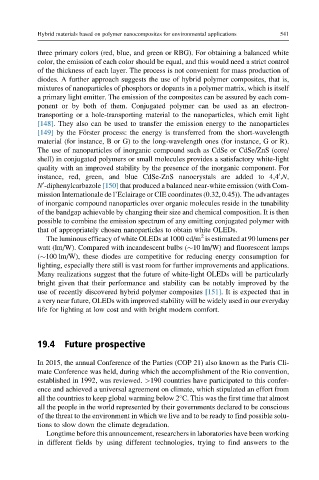Page 588 - Polymer-based Nanocomposites for Energy and Environmental Applications
P. 588
Hybrid materials based on polymer nanocomposites for environmental applications 541
three primary colors (red, blue, and green or RBG). For obtaining a balanced white
color, the emission of each color should be equal, and this would need a strict control
of the thickness of each layer. The process is not convenient for mass production of
diodes. A further approach suggests the use of hybrid polymer composites, that is,
mixtures of nanoparticles of phosphors or dopants in a polymer matrix, which is itself
a primary light emitter. The emission of the composites can be assured by each com-
ponent or by both of them. Conjugated polymer can be used as an electron-
transporting or a hole-transporting material to the nanoparticles, which emit light
[148]. They also can be used to transfer the emission energy to the nanoparticles
[149] by the F€ orster process: the energy is transferred from the short-wavelength
material (for instance, B or G) to the long-wavelength ones (for instance, G or R).
The use of nanoparticles of inorganic compound such as CdSe or CdSe/ZnS (core/
shell) in conjugated polymers or small molecules provides a satisfactory white-light
quality with an improved stability by the presence of the inorganic component. For
instance, red, green, and blue CdSe-ZnS nanocrystals are added to 4,4 ,N,
0
N -diphenylcarbazole [150] that produced a balanced near-white emission (with Com-
0
mission Internationale de l’Eclairage or CIE coordinates (0.32, 0.45)). The advantages
of inorganic compound nanoparticles over organic molecules reside in the tunability
of the bandgap achievable by changing their size and chemical composition. It is then
possible to combine the emission spectrum of any emitting conjugated polymer with
that of appropriately chosen nanoparticles to obtain white OLEDs.
2
The luminous efficacy of white OLEDs at 1000 cd/m is estimated at 90 lumens per
watt (lm/W). Compared with incandescent bulbs ( 10 lm/W) and fluorescent lamps
( 100 lm/W), these diodes are competitive for reducing energy consumption for
lighting, especially there still is vast room for further improvements and applications.
Many realizations suggest that the future of white-light OLEDs will be particularly
bright given that their performance and stability can be notably improved by the
use of recently discovered hybrid polymer composites [151]. It is expected that in
a very near future, OLEDs with improved stability will be widely used in our everyday
life for lighting at low cost and with bright modern comfort.
19.4 Future prospective
In 2015, the annual Conference of the Parties (COP 21) also known as the Paris Cli-
mate Conference was held, during which the accomplishment of the Rio convention,
established in 1992, was reviewed. >190 countries have participated to this confer-
ence and achieved a universal agreement on climate, which stipulated an effort from
all the countries to keep global warming below 2°C. This was the first time that almost
all the people in the world represented by their governments declared to be conscious
of the threat to the environment in which we live and to be ready to find possible solu-
tions to slow down the climate degradation.
Longtime before this announcement, researchers in laboratories have been working
in different fields by using different technologies, trying to find answers to the

